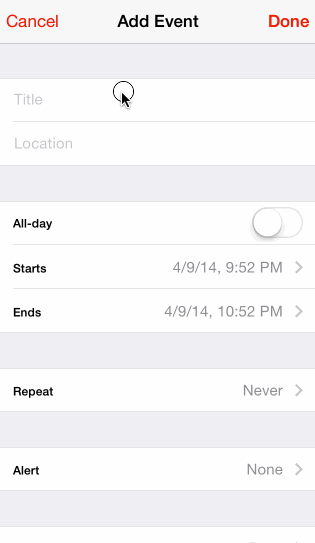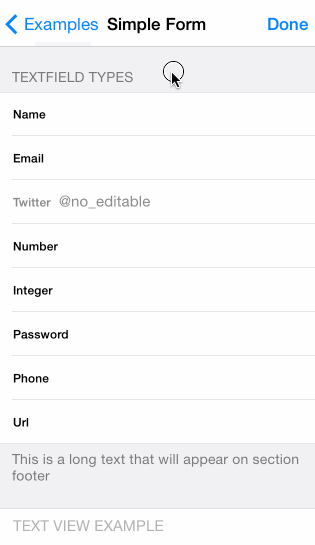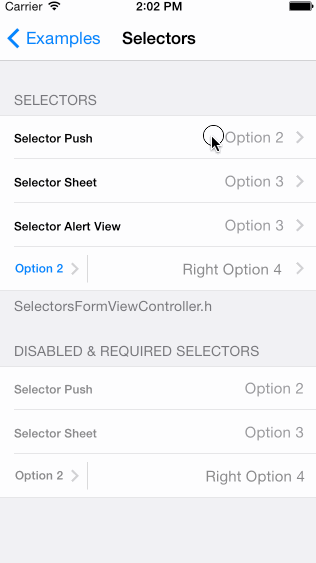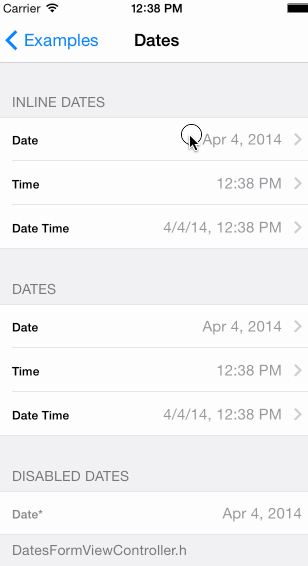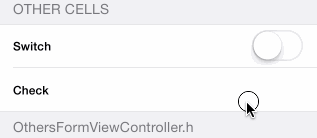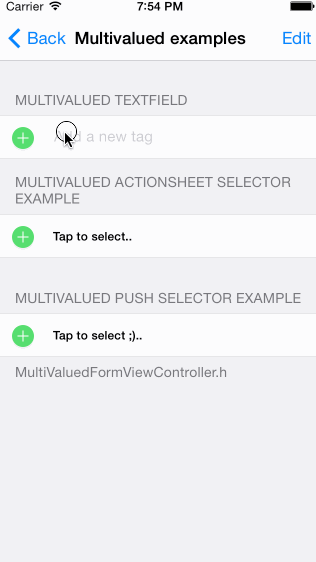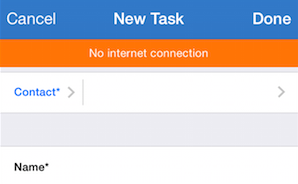#XMARTLABS - XLForm
Purpose
XLForm is the most flexible and powerful iOS library to create dynamic table-view forms. The goal of the library is to get the same power of hand-made forms but spending 1/10 of the time.
XLForm provides a very powerful DSL used to create a form, validate & serialize the form data. It keeps track of this specification on runtime, updating the UI on the fly.
#####Let's see the iOS 7 Calendar Event Form created using XLForm
What XLForm does
- Loads a form based on a declarative form definition.
- Keeps track of definition changes on runtime to update the form interface accordingly. Further information on Dynamic Forms section of this readme.
- Supports multivalued sections. For further details see Multivalued Sections section bellow.
- Shows the Cancel and Done buttons. The form view controller (XLFormViewCotnroller instance or any subclass of it) must be contained on a UINavigationController.
- Validates the form data based on form definition and shows error messages.
- Serializes form data using
AFNetworking 2.0. - Shows no internet connection message using AFNetworking network reachability support.
- Shows asynchronous indicator when a server request is happening using MRProgress.
- Has support for Create and Edit modes.
- Supports core data objects and dynamic selectors using XLDataLoader.
- Changes the firstResponder among
UITextFields andUITextViews when keyboard return button is pressed.
How to create a form
To create a form we should declare it through a XLFormDescriptor instance and assign it to a XLFormViewController instance. As we said XLForm works based on a DSL that hides complex and boilerplate stuff without losing the power and flexibility of hand-made forms.
To define a form we use 3 classes:
XLFormDescriptorXLFormSectionDescriptorXLFormRowDescriptor
A form definition is a XLFormDescriptor instance that contains one or more sections (XLFormSectionDescriptor instances) and each section contains several rows (XLFormRowDescriptor instance). As you may have noticed the DSL structure is analog to the structure of a UITableView (Table -->> Sections -- >> Rows). The resulting table-view form's structure (sections and rows order) mirrors the definition's structure.
#####Let's see part of the iOS 7 Calendar Event Form definition.
XLFormDescriptor * form;
XLFormSectionDescriptor * section;
XLFormRowDescriptor * row;
form = [XLFormDescriptor formDescriptorWithTitle:@"Add Event"];
// First section
section = [XLFormSectionDescriptor formSectionWithTitle:nil];
[form addFormSection:section];
// Title
row = [XLFormRowDescriptor formRowDescriptorWithTag:@"title" rowType:XLFormRowDescriptorTypeText];
[row.cellConfigAtConfigure setObject:@"Title" forKey:@"textField.placeholder"];
[section addFormRow:row];
// Location
row = [XLFormRowDescriptor formRowDescriptorWithTag:@"location" rowType:XLFormRowDescriptorTypeText];
[row.cellConfigAtConfigure setObject:@"Location" forKey:@"textField.placeholder"];
[section addFormRow:row];
// Second Section
section = [XLFormSectionDescriptor formSectionWithTitle:nil];
[form addFormSection:section];
// All-day
row = [XLFormRowDescriptor formRowDescriptorWithTag:@"all-day" rowType:XLFormRowDescriptorTypeBooleanSwitch title:@"All-day"];
[section addFormRow:row];
// Starts
row = [XLFormRowDescriptor formRowDescriptorWithTag:@"starts" rowType:XLFormRowDescriptorTypeDateTimeInline title:@"Starts"];
row.value = [NSDate dateWithTimeIntervalSinceNow:60*60*24];
[section addFormRow:row];
XLForm will load the table-view form from the previously explained definition. The most interesting part is that it will update the table-view form based on the form definition modifications.
That means that we are able to make changes on the table-view form adding or removing section definitions or row definitions to the form definition on runtime and you will never need to care again about NSIndexPath, UITableViewDelegate, UITableViewDataSource or other complexities.
To see more complex form definitions take a look at the example application in the Examples folder of this repository. You can also run the examples on your own device if you wish.
Rows
####Input Rows
Input rows allows the user to enter text values. Basically they use UITextField or UITextView controls. The main differences among the input row types is the keyboardType, autocorrectionType and autocapitalizationType configuration.
static NSString *const XLFormRowDescriptorTypeText = @"text";Will be represented by a UITextField with UITextAutocorrectionTypeDefault, UITextAutocapitalizationTypeSentences and UIKeyboardTypeAlphabet.
static NSString *const XLFormRowDescriptorTypeName = @"name";Will be represented by a UITextField with UITextAutocorrectionTypeNo, UITextAutocapitalizationTypeWords and UIKeyboardTypeAlphabet.
static NSString *const XLFormRowDescriptorTypeURL = @"url";Will be represented by a UITextField with UITextAutocorrectionTypeNo, UITextAutocapitalizationTypeNone and UIKeyboardTypeURL.
static NSString *const XLFormRowDescriptorTypeEmail = @"email";Will be represented by a UITextField with UITextAutocorrectionTypeNo, UITextAutocapitalizationTypeNone and UIKeyboardTypeEmailAddress.
static NSString *const XLFormRowDescriptorTypePassword = @"password";Will be represented by a UITextField with UITextAutocorrectionTypeNo, UITextAutocapitalizationTypeNone and UIKeyboardTypeAlphabet.
This row type also set the secureTextEntry to YES in order to hide what the user types.
static NSString *const XLFormRowDescriptorTypeNumber = @"number";Will be represented by a UITextField with UITextAutocorrectionTypeNo, UITextAutocapitalizationTypeNone and UIKeyboardTypeNumbersAndPunctuation.
static NSString *const XLFormRowDescriptorTypePhone = @"phone";Will be represented by a UITextField with UIKeyboardTypePhonePad.
static NSString *const XLFormRowDescriptorTypeTwitter = @"twitter";Will be represented by a UITextField with UITextAutocorrectionTypeNo, UITextAutocapitalizationTypeNone and UIKeyboardTypeTwitter.
static NSString *const XLFormRowDescriptorTypeAccount = @"account";Will be represented by a UITextField with UITextAutocorrectionTypeNo, UITextAutocapitalizationTypeNone and UIKeyboardTypeAlphabet.
static NSString *const XLFormRowDescriptorTypeInteger = @"integer";Will be represented by a UITextField with UIKeyboardTypeNumberPad.
static NSString *const XLFormRowDescriptorTypeTextView = @"textView";Will be represented by a UITextView with UITextAutocorrectionTypeDefault, UITextAutocapitalizationTypeSentences and UIKeyboardTypeAlphabet.
####Selector Rows
Selector rows allow us to select a value or values from a list. This list of values could be fetched from a server endpoint, Core Data NSFetchResult or just a NSArray. XLForm supports 4 types of selectors out of the box:
static NSString *const XLFormRowDescriptorTypeSelectorPush = @"selectorPush";static NSString *const XLFormRowDescriptorTypeSelectorActionSheet = @"selectorActionSheet";static NSString *const XLFormRowDescriptorTypeSelectorAlertView = @"selectorAlertView";static NSString *const XLFormRowDescriptorTypeSelectorLeftRight = @"selectorLeftRight";Normally we will have a collection of object to select (these objects should have a string to display them and a value in order to serialize them), XLForm has to be able to display these objects as well as to be able to create the object HTTP parameter properly.
XLForm follows the following rules to display an object:
- If the object is a
NSStringorNSNumberit uses the objectdescriptionproperty. - If the object conforms to protocol
XLFormOptionObject, XLForm gets the display value fromformDisplayTextmethod. - Otherwise it return nil. That means you should conforms the protocol
:).
XLForm follows the following rules to get the object HTTP parameter value:
- If the object is a
NSString,NSNumberorNSDateit uses the object itself as the HTTP parameter value. - If the object conforms to protocol
XLFormOptionObject, XLForm gets the http parameter value fromformValuemethod. - Otherwise it return nil. That means you should conforms the protocol :).
This is the protocol declaration:
@protocol XLFormOptionObject <NSObject>
@required
-(NSString *)formDisplayText;
-(id)formValue;
@end####Date Rows
XLForms supports 3 types of dates: Date, DateTime and Time and it's able to present the UIDatePicker control in 2 different ways, inline and non-inline.
static NSString *const XLFormRowDescriptorTypeDateInline = @"dateInline";static NSString *const XLFormRowDescriptorTypeDateTimeInline = @"datetimeInline";static NSString *const XLFormRowDescriptorTypeTimeInline = @"timeInline";static NSString *const XLFormRowDescriptorTypeDate = @"date";static NSString *const XLFormRowDescriptorTypeDateTime = @"datetime";static NSString *const XLFormRowDescriptorTypeTime = @"time";Here is an example of how to define these row types:
XLFormDescriptor * form;
XLFormSectionDescriptor * section;
XLFormRowDescriptor * row;
form = [XLFormDescriptor formDescriptorWithTitle:@"Dates"];
section = [XLFormSectionDescriptor formSectionWithTitle:@"Inline Dates"];
[form addFormSection:section];
// Date
row = [XLFormRowDescriptor formRowDescriptorWithTag:kDateInline rowType:XLFormRowDescriptorTypeDateInline title:@"Date"];
row.value = [NSDate new];
[section addFormRow:row];
// DateTime
row = [XLFormRowDescriptor formRowDescriptorWithTag:kTimeInline rowType:XLFormRowDescriptorTypeTimeInline title:@"Time"];
row.value = [NSDate new];
[section addFormRow:row];
// Time
row = [XLFormRowDescriptor formRowDescriptorWithTag:kDateTimeInline rowType:XLFormRowDescriptorTypeDateTimeInline title:@"Date Time"];
row.value = [NSDate new];
[section addFormRow:row];####Boolean Rows
XLForms supports 2 types of boolean controls:
static NSString *const XLFormRowDescriptorTypeBooleanCheck = @"booleanCheck";static NSString *const XLFormRowDescriptorTypeBooleanSwitch = @"booleanSwitch";We can also simulate other types of Boolean rows using any of the Selector Row Types introduced in the Selector Rows section.
Multivalued Sections
Any XLFormSectionDescriptor could be set up to support multivalued rows. Multivalued Sections let the user enter multiple values (of the same type) for a field by adding or removing rows. The most interesting part of multivalued XLFormSectionDescriptor is that it supports all the types of rows that were shown on the Rows section.
How to set up a multivalued section
To create a multivalued section we should set YES to the isMultivaluedSection property of XLFormSectionDescriptor. We can also do that creating the XLFormSectionDescriptor instance using the this alternative constructor:
+(id)formSectionWithTitle:(NSString *)title multivaluedSection:(BOOL)multivaluedSection;We have also to set up the multiValuedTag property. multiValuedTag will be used to create the HTTP parameter key for the collection of values (rows added to the section).
XLFormDescriptor * form;
XLFormSectionDescriptor * section;
XLFormRowDescriptor * row;
NSArray * nameList = @[@"family", @"male", @"female", @"client"];
form = [XLFormDescriptor formDescriptorWithTitle:@"Multivalued examples"];
// MultivaluedSection section
section = [XLFormSectionDescriptor formSectionWithTitle:@"MultiValued TextField" multivaluedSection:YES];
section.multiValuedTag = @"textFieldRow";
[form addFormSection:section];
for (NSString * tag in nameList) {
// add a row to the section, each row will represent a name of the name list array.
row = [XLFormRowDescriptor formRowDescriptorWithTag:nil rowType:XLFormRowDescriptorTypeText title:nil];
[[row cellConfig] setObject:@"Add a new tag" forKey:@"textField.placeholder"];row.value = [tag copy];
[section addFormRow:row];
}
// add an empty row to the section.
row = [XLFormRowDescriptor formRowDescriptorWithTag:nil rowType:XLFormRowDescriptorTypeText title:nil];
[[row cellConfig] setObject:@"Add a new tag" forKey:@"textField.placeholder"];
[section addFormRow:row];Request Parameters
XLForm uses AFNetworking to make HTTP requests to the server. It uses POST, PUT and DELETE to create, update, delete an entity respectively.
HTTP parameters of the request are created from the XLFormDescriptor instance.
XLForm adds an HTTP parameter for each multivalued section containing an NSArray with the instance values of the XLFormRowDescriptors contained in the section.
For instance, if we have a section with the tag property equal to tags and the following values on the contained rows: 'family', 'male', 'female', 'client', the generated parameter will be tags: ['family', 'male', 'female', 'client']
It also adds a parameter for each XLFormRowDescriptor instance not contained in a multivalued section, the name of the parameter is the value of the tag property.
In same cases the value of the HTTP parameter may differ from the value of XLFormRowDescriptor instance. This is usually the case of selectors row, the selected value could be a core data object or any other object. In this cases XLForm need to know how to get the value and the description of the selected object.
AFNetworking is in charge of parameters serialization.
How to make HTTP requests to create, update, delete the entity represented by the Form
Your XLFormViewController concrete class should implement -(void)configureDataManager:(XLFormDataManager *)dataManager; in order to configure the data necessary to make the HTTP request. -(void)configureDataManager:(XLFormDataManager *)dataManager; is part of XLFormViewControllerDelegate protocol.
This is an example of how we can implement this method:
-(void)configureDataManager:(XLFormDataManager *)dataManager
{
Customer *customer;
if (self.customerObjectID) {
customer = [Customer objectWithID:self.customerObjectID inContext:[AppDelegate managedObjectContext]];
}
switch (self.formMode) {
case XLFormModeCreate:
dataManager.sessionManager = [LynkosHttpSessionManager sharedClient];
dataManager.urlString = self.contactDataType == XLContactDataTypeCompany ? @"customers/createcorporate" : @"customers/create";
dataManager.parameters = self.httpParameters;
dataManager.httpMethod = @"POST";
break;
case XLFormModeEdit:
dataManager.sessionManager = [LynkosHttpSessionManager sharedClient];
dataManager.urlString = [NSString stringWithFormat:@"customers/%@/%@", customer.customerId, (customer.isCompany ? @"updatecorporate" : @"update")];
dataManager.parameters = self.httpParameters;
dataManager.httpMethod = @"PUT";
break;
case XLFormModeDelete:
dataManager.sessionManager = [LynkosHttpSessionManager sharedClient];
dataManager.urlString = [NSString stringWithFormat:@"customers/%@/delete", customer.customerId];
dataManager.parameters = nil;
dataManager.httpMethod = @"DELETE";
break;
default:
break;
}
}A real example will be added on the example application soon.
Selector Rows with remote data loaders
This section will be documented soon.
Dynamic Forms - How to change the form dynamically at runtime
Any change made on the XLFormDescriptor will be reflected on the XLFormViewController tableView. That means that we can add or remove sections or rows at any time and XLForm will animate the section or row accordingly.
We shouldn't have again to work with NSIndexPaths or add, remove UITableViewCell. NSIndexPath of a specific TableViewCell changes along the time and this makes very hard to keep track of the NSIndexPath of each UITableViewCell.
On XLForm, each XLFormRowDescriptor has a tag property that is set up in its constructor. XLFormDescriptor has, among other helpers, an specific one to get a XLFormRowDescriptor from a tag.
It's much easier to manage XLFormRowDescriptors using tags, the tag should be unique and it doesn't change on tableview additions modifications or deletions.
It's important keep in mind that all the UITableView form modifications have to be made using the descriptors and not making modifications directly on the UITableView.
Usually you may want to change the form when some value change or some row or section is added or removed. In order to keep posted about the form descriptor modifications your XLFormViewController subclass should override the XLFormDescriptorDelegate methods of 'XLFormViewController'.
@protocol XLFormDescriptorDelegate <NSObject>
@required
-(void)formSectionHasBeenRemovedAtIndex:(NSUInteger)index;
-(void)formSectionHasBeenAdded:(XLFormSectionDescriptor *)sectionDescriptor atIndex:(NSUInteger)index;
-(void)formRowHasBeenRemovedAtIndexPath:(NSIndexPath *)indexPath;
-(void)formRowHasBeenAdded:(XLFormRowDescriptor *)rowDescriptor atIndexPath:(NSIndexPath *)indexPath;
-(void)formRowDescriptorValueHasChanged:(XLFormRowDescriptor *)rowDescriptor oldValue:(id)oldValue newValue:(id)newValue;
@endFor instance if we want to show or hide a row depending on the value of another row:
-(void)formRowDescriptorValueHasChanged:(XLFormRowDescriptor *)rowDescriptor oldValue:(id)oldValue newValue:(id)newValue
{
[super formRowDescriptorValueHasChanged:rowDescriptor oldValue:oldValue newValue:newValue];
if ([rowDescriptor.tag isEqualToString:@"alert"]){
if ([[rowDescriptor.value valueData] isEqualToNumber:@(0)] == NO && [[oldValue valueData] isEqualToNumber:@(0)]){
XLFormRowDescriptor * newRow = [rowDescriptor copy];
[newRow setTag:@"secondAlert"];
newRow.title = @"Second Alert";
[self.form addFormRow:newRow afterRow:rowDescriptor];
}
else if ([[oldValue valueData] isEqualToNumber:@(0)] == NO && [[newValue valueData] isEqualToNumber:@(0)]){
[self.form removeFormRowWithTag:@"secondAlert"];
}
}Validations
XLForm supports 2 types of app validation so far.
- Is Required Validation.
- Email validation.
Improving XLForms validation support is in the roadmap.
XLForm shows one error at a time showing it as UIAlertView.
You may want to change the list of validation errors. You can do that overriding the following method of XLFormViewController, please make sure you call superclass implementation.
-(NSArray *)formValidationErrors;You can also change the way the error messages are shown overriding:
-(void)showFormValidationError:(NSError *)error;XLForm also serializes and sends the form through an HTTP message to the app backend. Basically it makes the POST, PUT or DELETE request with the serialized data. The HTTP response of the request could result in a error, in that case the framework calls -(void)showServerErrorMessage:(NSError *)error method. You should override it if you want to show a custom message.
For Instance:
-(void)showServerErrorMessage:(NSError *)error
{
if (error.userInfo[AFNetworkingTaskDidCompleteSerializedResponseKey])
{
id responseData = error.userInfo[AFNetworkingTaskDidCompleteSerializedResponseKey];
if ([responseData isKindOfClass:[NSDictionary class]]){
NSDictionary * data = (NSDictionary *)responseData;
if ([data objectForKey:@"code"]){
// do something useful
}
}
}
} Additional configuration of Rows
XLFormRowDescriptor allow us to configure generic aspects of a UITableViewCell, for example: the rowType, the label, the value (default value), if the cell is required or disabled, and so on.
You may want to set up another properties of the UITableViewCell. To set up another properties XLForm makes use of Key-Value Coding allowing the developer to set the cell properties by keyPath.
You just have to add the properties to cellConfig or cellConfigAtConfigure dictionary property of XLFormRowDescriptor.
The main difference between cellConfig and cellConfigAtConfigure is the time when the property is set up. cellConfig properties are set up each time before display a cell. cellConfigAtConfigure, on the other hand, set up the property just after the init method of the cell is called and only one time.
For instance if you want to set up the placeholder you can do the following:
row = [XLFormRowDescriptor formRowDescriptorWithTag:@"title" rowType:XLFormRowDescriptorTypeText];
[row.cellConfigAtConfigure setObject:@"Title" forKey:@"textField.placeholder"];
[section addFormRow:row];Let's see how to change the color of the cell label:
row = [XLFormRowDescriptor formRowDescriptorWithTag:@"title" rowType:XLFormRowDescriptorTypeText];
[row.cellConfigAtConfigure setObject:[UIColor red] forKey:@"textLabel.textColor"];
[section addFormRow:row];Advanced Functionality
How to show "no internet connection" network reachability message
- Set
XLFormViewControllershowNetworkReachabilityproperty toYES. - Implement the method:
(AFHTTPSessionManager *)sessionManager;which is a method of XLFormViewControllerDelegate protocol.
How to show the Delete button at the end of the table view
Delete Button will appear only if formMode is passed as XLFormModeEdit and showDeleteButton is passed as YES.
We should invoke the XLFormViewController using these parameter values.
-(id)initWithForm:(XLFormDescriptor *)form formMode:(XLFormMode)mode showCancelButton:(BOOL)showCancelButton showSaveButton:(BOOL)showSaveButton showDeleteButton:(BOOL)showDeleteButton deleteButtonCaption:(NSString *)deleteButtonCaption;We can also change the delete button caption setting the deleteButtonCaption accordingly.
How to show the Cancel and Done button
To show the Cancel and Done buttons the XLFormViewController instance must be contained in a UINavigatorViewController. In addition to that we has to pass the XLFormViewControllers showCancelButton and showSaveButton parameters to YES.
XLForm will create a UIBarButtonItem for each one.
How to assign the first responder on form appearance
Assign the first responder when the form is shown is as simple as setting the property assignFirstResponderOnShow to YES. By default the value of the property is NO.
@property (nonatomic) BOOL assignFirstResponderOnShow;Installation
The easiest way to use XLForm in your app is via CocoaPods.
- Add the following line in the project's Podfile file:
pod 'XLForm'. - Run the command
pod installfrom the Podfile folder directory.
Requirements
- ARC
- iOS 7.0 and above
Release Notes
Version 1.0
- Initial release
Contact
If you are using XLForm in your app and have any suggestion or question:
Martin Barreto, martin@xmartlabs.com, @mtnBarreto
